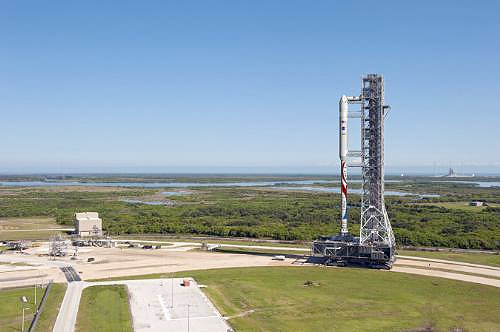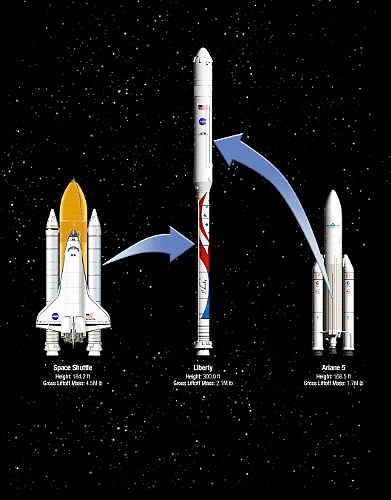
The new Liberty launch vehicle will use existing infrastructure at Kennedy Space Center, such as the Mobile Launcher shown here. (PRNewsFoto/ATK)
The team is offering NASA launch services with the Liberty™ rocket. This new launch vehicle combines two of the world's most reliable propulsion systems, with a collective heritage of nearly 150 successful flights. ATK would supply the human-rated first stage, which it developed under NASA's Space Exploration Program. The five-segment solid rocket first stage is derived from the Space Shuttle's four-segment solid rocket boosters (SRBs) which are built by ATK and have flown 107 successful missions since 1988 (encompassing 214 SRBs).

The Liberty launch vehicle combines the proven systems from the Space Shuttle and Ariane 5. (PRNewsFoto/ATK)
Liberty would be a two stage launcher able to deliver 44,500 pounds to the International Space Station orbit, which would give it a launch capability to carry any crew vehicle in development. Both stages were designed for human-rating since inception and would enable unmatched crew safety. Since Liberty uses qualified, proven, and reliable systems, the team has planned an initial flight by the end of 2013, a second test flight in 2014, and operational capability in 2015. The advantages of the Liberty launch system are extensive. It is built on a solid foundation of human-rated launch technology, and leverages billions of dollars of investments by NASA and NATO-allied European Governments in the frame of the European Space Agency. This international effort—which embodies the spirit of global cooperation articulated in the recent National Space Policy—will afford NASA a readily available, cost-effective solution for human spaceflight. Finally, NASA is already extremely familiar with the Ariane and ATK launch systems, both of which have played historic roles in directly supporting NASA's mission.
The five-segment first stage design is based on more than 30 years of safety-driven improvements on the space shuttle program. The result is a higher performing, more reliable solid rocket motor, which equates to increased safety for crew and mission success for cargo. In addition to adding a fifth segment, ATK also enhanced the propellant grain, provided a larger nozzle opening, and upgraded the liner and insulation — all designed to meet performance requirements and increase reliability while significantly lowering manufacturing costs. The five-segment first stage was successfully ground tested twice (September 2009 and August 2010), and the successful Ares I-X flight test in October 2009 demonstrated vehicle proof of concept, and vital flight performance of a launch vehicle configuration very comparable to Liberty. It also demonstrated effective vehicle integration, ground processing and launch operations. Other Liberty team members include: United Space Alliance (USA) of Houston, Texas, and Kennedy Space Center, Florida, for launch vehicle integration and ground operations support, and L-3 Communications of Cincinnati, Ohio, for first stage avionics.

